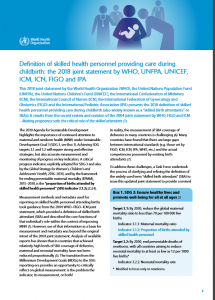
The 2030 Agenda for Sustainable Development highlights the importance of continued attention to maternal and newborn health (MNH) under Sustainable Development Goal 3 (SDG 3, see Box 1). Achieving SDG targets 3.1 and 3.2 will require strong and effective strategies, but also accurate measurement and monitoring of progress on key indicators. A critical progress indicator, explicitly adopted for SDG 3 and also by the Global Strategy for Women’s, Children’s and Adolescents’ Health, 2016–2030, and by the framework for ending preventable maternal mortality (EPMM), 2015–2030, is the “proportion of births attended by skilled health personnel” (SDG indicator 3.1.2) (2,3,4).
Measurement methods and metadata used for reporting on skilled health personnel attending births took guidance from the 2004 WHO–FIGO–ICM joint statement, which provided a definition of skilled birth attendant (SBA) and described the core functions of that individual’s role within the context of improving MNH (1). However, use of that information as a basis for measurement and metadata was beyond the original intent of the 2004 joint statement. Analysis of available reports has shown that in countries that achieved relatively high levels of SBA coverage of deliveries, maternal and neonatal mortality have not been reduced proportionally (5). The transition from the Millennium Development Goals (MDGs) to the SDG reporting era provides an opportunity to critically reflect on global measurement: is the problem the indicator, its measurement, or both?
In reality, the measurement of SBA coverage of deliveries in many countries is challenging (6). Many countries have found that there are large gaps between international standards (e.g. those set by FIGO, ICM, ICN, IPA, WHO, etc.) and the actual competencies possessed by existing birth attendants (7).
To address these challenges, a Task Force undertook the process of clarifying and refining the definition of the widely used term “skilled birth attendant” (SBA) to issue this updated joint statement to provide a revised definition of “skilled health personnel” providing care during childbirth, with the aim of supporting more robust measurement and metadata, as required by the SDGs, for indicator 3.1.2 in particular.
The scope of this new joint statement has been expanded from a narrow focus on SBAs as individuals. The main differences between the 2004 and the 2018 definition of skilled health personnel providing care during childbirth are that, under the revised definition, these are personnel who can provide effective, uninterrupted and quality care because they are: (a) competent MNH professionals who hold identified competencies (and as a team, these professionals possess all the MNH competencies in the eight categories listed in Box 2); (b) educated, trained and regulated to national and international standards; and (c) supported within an enabling environment comprising the six building blocks of the health system. Figure 1 on the next page presents a conceptual framework illustrating all of these elements, with the MNH professional providing care during childbirth at the centre.